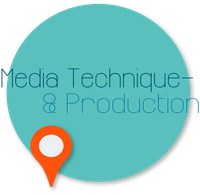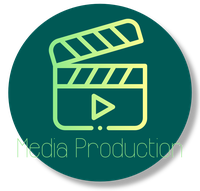Media Technique and Media Production
 |
Soon you will find further content on the topic "Media Technique & Production" in the area of e-learning in university teaching.
This page is constantly growing with the project and is regularly filled with new content. Unless otherwise stated, the following sources are valid: e-teaching.org • ilias.uni-giessen.de/ilias |
||||
|---|---|---|---|---|---|
 |
JLU's university computer centre supports you not only with advice, planning, acquisition and installation of media equipment in classrooms, but also with media production.
The HRZ provides a video, sound and photo studio as well as an editing room. The HRZ staff will be happy to assist you in using the studios and support you in your project.
|
||||
 |
In the film studio, high-quality audio and video productions can be created for the JLU Giessen. | ||||
 |
Due to the good technical infrastructure such as lighting, e.g. powerful "softboxes" and permanently installed "backgrounds", high-quality photo productions can be carried out in the photo studio. |
||||
 |
You would like to enrich your teaching concept with an audio podcast? In the recording studio high-quality voice recordings can be made. | ||||
 |
The editing room has a PC with Adobe Production Suite CS6. The editing suite can be connected to the sound studio next door for high-quality voice recordings. | ||||
 |
Event and lecture recordings have been offered by the HRZ for over 5 years and provide you with the opportunity to quickly and efficiently implement learning content electronically. The HRZ staff will be happy to support and advise you in planning and implementation. Please note the requirements and conditions of the HRZ. |
||||
 |
In addition to operating system editing programs such as Windows Movie Maker (Windows 7) or iMovie (Mac), you can use the following programs and applications to edit, cut or post-process your videos by yourself.
Please note that some of the software is subject to charge or applications that require registration (ATTENTION! Note the data protection guidlines!). Please note, all the application examples are in german
|
||||
|
Publishing videos
Record your video and edit the recording (suitable software see above) Export Export your video as .mp4 file. Compress Compress your .mp4 file into a web-enabled format. Upload Upload the compressed .mp4 file to the streaming server of the JLU University Computer Center. Publish Integrate the video link in Stud.IP (e.g. on an information page, in a wiki) or in ILIAS (e.g. as a contribution in a mediacast, as an e-lecture, as a media object in a media pool, as an interactive video) into your ILIAS course. |
|||||
 |
Handbrake A course usually lasts 90 minutes. The longer the video recording, the larger the file size in megabyte (MB). Before you make your video file (.mp4 with reduced bit rate, no Full-HD!) available to your students, you should compress it into a web-compatible format. Depending on how much movement is in the video, the file size for a 2-minute video should be around 10 to 15 MB. 90-minute lecture recordings should therefore be about 500 to 600 MB in size. You can convert your original camera recordings into a web-enabled format using the Handbrake programme, which is available free of charge.
|
||||
|
Streaming server of the University Computer Centre Since May 2004, the University Computer Centre has operated its own streaming server. The streaming procedure allows audio and video files to be viewed on the Internet without having to load the sometimes very large files completely. This has the advantage that the media files can be viewed very quickly.
|
|||||
|
Publish your video streams and ideally make them available in ILIAS, Stud.IP or Plone. In the e-learning guide you will find several possibilities to integrate your video stream on the different platforms:
Embedding the video streams on ILIAS
Embedding the video streams on Stud.IP
Embedding the videos streams on Plone
|
|||||
|
|||||
